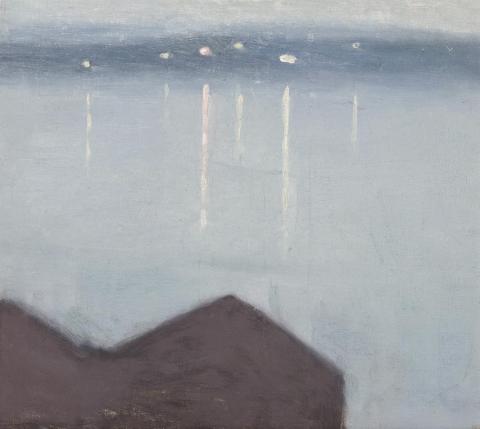LIGHTS ACROSS THE BAY, c.1931
CLARICE BECKETT
oil on canvas
37.5 x 42.0 cm
Rosalind Humphries Galleries, Melbourne
Private collection, Adelaide
Deutscher Fine Art, Melbourne
Private collection, Melbourne
Rosalind Humphries Galleries, Melbourne, 12 November – 1 December 1972 (label attached verso)
Lights Across the Bay, c1931 is one of a series of hauntingly beautiful nocturnal paintings that Clarice Beckett painted along the foreshore of Port Phillip Bay from Sandringham to St Kilda. While nocturnes figured throughout her career, they became a focus from about 1931, as she began to concentrate on the effects of electric lights in the city streets of Melbourne and across the Yarra River.
Beckett's originality and artistic vision is clear in this painting and a prime example of how she approached her subject matter, both physically and intellectually. This picture borders on the abstract and demonstrates her attraction to soft edges, pared back forms and a sparse use of paint while accentuating the flatness of the board. Beckett's innovative approach to style developed alongside her desire to express a different perception of reality, revealing both her confidence in, and mastery over her materials. The deceptive appearance of simplicity in this painting only bears testimony to her unfettered ability.
Lights Across the Bay expresses Beckett's intuitive feel for composition and Japanese-style open design principles, including asymmetrical balance, absence of artificiality, and profundity with subtle austerity and active calm. Beckett was also inspired by the Japanese artist Hiroshige's use of unusual vantage points.
This classic example of Beckett's en plein air work demonstrates her spontaneity and passion for seeking the essence of the transient moment; these fused with a powerful sense of place work to create an emotional impact. The feeling of descending night brings an intense awareness of lucency, contributing to the experience of immediacy. Beckett's renowned skill in accurately achieving the subtle gradation of tones, and her lack of obvious brushstroke, adds to the initial impression that this painting has silently and mysteriously metamorphosed out of pure air.
Tranquillity breathes through this painting with its distant horizon composed of an illusive strip of dusky coastline, a calm expanse of silvery sea and the anchoring forms of the muffled, warm-toned, boatsheds in the foreground. Yet at the heart of this image, the lights pierce through the flatness of the image with their reflections carrying a needle like intensity across the water, suggesting depth and bringing an element of perspectival distance that saves the image from total abstraction. The creative addition of a touch of red in one light and its reflection is a crucial accent to the whole composition; it is a likely construct to add a point of difference to lift the entire scene to a new level of expressive feeling.
Beckett likened her pictures to music with reference to its power to alter our perceptions by offering intense emotional experiences. Chopin's lyrically beautiful piano nocturnes resonate within the tonal perfection reached in this image, yet in its aim this image is devoid of any association with romanticism or the picturesque. What Beckett achieved was an innovative way of perceiving reality, with her own individual modernist approach to create a vision that is local, universal and eternal in its appeal.
ROSALIND HOLLINRAKE
